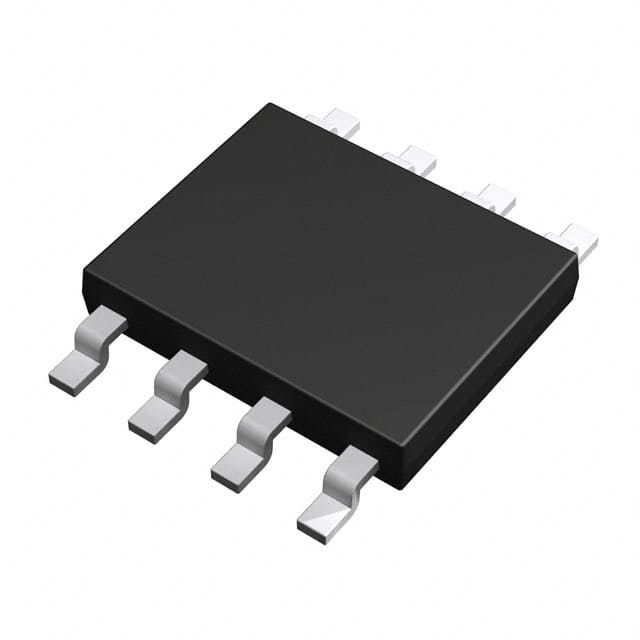Viz Specifikace pro podrobnosti o produktu.

BR93G86FVM-3GTTR
Basic Information Overview
- Category: Integrated Circuit (IC)
- Use: Non-volatile Memory
- Characteristics: High-speed, Low-power consumption
- Package: SOP-8 (Small Outline Package)
- Essence: Serial EEPROM (Electrically Erasable Programmable Read-Only Memory)
- Packaging/Quantity: Tape and Reel, 3000 units per reel
Specifications
- Memory Capacity: 8 kilobits (1 kilobyte)
- Interface: Serial I2C (Inter-Integrated Circuit)
- Operating Voltage: 1.7V to 5.5V
- Operating Temperature Range: -40°C to +85°C
- Write Endurance: 1 million cycles
- Data Retention: 100 years
Detailed Pin Configuration
The BR93G86FVM-3GTTR IC has a SOP-8 package with the following pin configuration:
| Pin Number | Pin Name | Function | |------------|----------|----------| | 1 | VSS | Ground | | 2 | SDA | Serial Data Input/Output | | 3 | SCL | Serial Clock Input | | 4 | WP | Write Protect | | 5 | VCC | Power Supply | | 6 | NC | No Connection | | 7 | NC | No Connection | | 8 | NC | No Connection |
Functional Features
- High-speed data transfer up to 400 kHz
- Low-power consumption for energy-efficient operation
- Built-in write protection feature (WP pin)
- Self-timed programming cycle for easy integration
- Automatic page write and sequential read functions
- Software write protection of entire memory or partial areas
Advantages
- Compact SOP-8 package allows for space-saving integration
- Wide operating voltage range enables compatibility with various systems
- High-speed data transfer enhances overall system performance
- Low-power consumption prolongs battery life in portable devices
- Long data retention period ensures reliable storage of critical information
Disadvantages
- Limited memory capacity compared to larger EEPROMs
- Lack of additional features such as hardware encryption or security measures
- Relatively higher cost per kilobit compared to larger memory chips
Working Principles
The BR93G86FVM-3GTTR is a serial EEPROM that utilizes electrically erasable and programmable memory cells. It operates based on the I2C protocol, allowing for easy interfacing with microcontrollers and other ICs. The memory cells store data in a non-volatile manner, meaning the information remains even when power is removed. The IC supports high-speed data transfer and offers write protection options to prevent accidental modification of stored data.
Detailed Application Field Plans
The BR93G86FVM-3GTTR is widely used in various electronic devices and systems, including but not limited to: - Consumer electronics (e.g., TVs, audio players) - Automotive applications (e.g., infotainment systems, engine control units) - Industrial equipment (e.g., factory automation, measurement devices) - Medical devices (e.g., patient monitoring systems, diagnostic equipment) - Communication devices (e.g., routers, modems)
Detailed and Complete Alternative Models
- BR93G66F-WE2: 4 kilobits, SOP-8 package, I2C interface
- AT24C256C-SSHL-T: 32 kilobits, SOP-8 package, I2C interface
- CAT24C08WI-GT3: 8 kilobits, SOP-8 package, I2C interface
- M95640-WMN6TP: 64 kilobits, SOP-8 package, I2C interface
(Note: The above alternative models are provided for reference and may have different specifications and features. It is recommended to consult the respective datasheets for detailed information.)
This encyclopedia entry provides an overview of the BR93G86FVM-3GTTR IC, including its basic information, specifications, pin configuration, functional features, advantages, disadvantages, working principles, application field plans, and alternative models.
Seznam 10 běžných otázek a odpovědí souvisejících s aplikací BR93G86FVM-3GTTR v technických řešeních
Sure! Here are 10 common questions and answers related to the application of BR93G86FVM-3GTTR in technical solutions:
Q: What is BR93G86FVM-3GTTR? A: BR93G86FVM-3GTTR is a specific model of non-volatile memory (NVM) chip used for storing data in various technical solutions.
Q: What are the key features of BR93G86FVM-3GTTR? A: Some key features of BR93G86FVM-3GTTR include a capacity of 8 kilobits, SPI interface, low power consumption, and high reliability.
Q: In which applications can BR93G86FVM-3GTTR be used? A: BR93G86FVM-3GTTR can be used in a wide range of applications such as automotive electronics, industrial control systems, consumer electronics, and IoT devices.
Q: How does BR93G86FVM-3GTTR connect to a microcontroller or system? A: BR93G86FVM-3GTTR connects to a microcontroller or system using the Serial Peripheral Interface (SPI) protocol.
Q: Can BR93G86FVM-3GTTR operate in harsh environments? A: Yes, BR93G86FVM-3GTTR is designed to operate reliably in harsh environments with a wide temperature range and resistance to vibration and shock.
Q: What is the programming voltage required for BR93G86FVM-3GTTR? A: The programming voltage required for BR93G86FVM-3GTTR is typically 2.7V to 5.5V.
Q: Does BR93G86FVM-3GTTR support data protection and security features? A: Yes, BR93G86FVM-3GTTR provides various data protection and security features such as write protection, password protection, and unique device ID.
Q: Can BR93G86FVM-3GTTR be used for firmware updates in embedded systems? A: Yes, BR93G86FVM-3GTTR can be used for storing firmware updates in embedded systems, allowing easy and efficient software upgrades.
Q: What is the typical endurance of BR93G86FVM-3GTTR? A: The typical endurance of BR93G86FVM-3GTTR is 1 million write cycles, ensuring long-term reliability and durability.
Q: Are there any development tools or resources available for working with BR93G86FVM-3GTTR? A: Yes, the manufacturer provides development tools, datasheets, application notes, and technical support to assist engineers in integrating BR93G86FVM-3GTTR into their designs.
Please note that the specific details and answers may vary depending on the manufacturer's documentation and specifications for BR93G86FVM-3GTTR.

